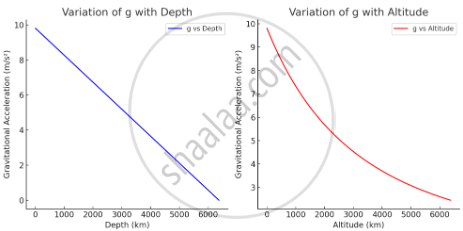Advertisements
Advertisements
प्रश्न
Answer the following question in detail.
Draw a graph showing the variation of gravitational acceleration due to the depth and altitude from the Earth’s surface.
उत्तर १

Variation of g due to depth and altitude from the Earth’s surface
उत्तर २

The graph above illustrates the variation of gravitational acceleration (g) due to both depth (inside the Earth) and altitude (above the Earth's surface).
Explanation:
- Gravitational Acceleration vs. Depth:
- As we move deeper into the Earth, the gravitational acceleration decreases linearly.
- This is because only the mass enclosed within the radius of depth contributes to gravity.
- The relation is given by: `g_d = g_o (1- d/R)`
- Where g0 is surface gravity, d is depth, and R is the Earth's radius.
- Gravitational Acceleration vs. Altitude:
- As we move higher above the Earth’s surface, gravitational acceleration decreases according to the inverse square law:
`g_h = g_o (1/(1+h/R)^2)` - Where h is the altitude above the surface.
- The further we go, the weaker Earth's gravitational pull becomes.
- As we move higher above the Earth’s surface, gravitational acceleration decreases according to the inverse square law:
APPEARS IN
संबंधित प्रश्न
Answer the following question.
What is the variation in acceleration due to gravity with altitude?
Answer the following question in detail.
Show that acceleration due to gravity at height h above the Earth’s surface is `"g"_"h" = "g"("R"/"R + h")^2`
Answer the following question in detail.
At which place on the Earth’s surface is the gravitational acceleration minimum? Why?
Answer the following question in detail.
At which place on the Earth’s surface is the gravitational acceleration maximum? Why?
Answer the following question in detail.
Obtain the formula for the acceleration due to gravity at the depth ‘d’ below the Earth’s surface.
Answer the following question in detail.
State the formula for the acceleration due to gravity at depth ‘d’ and altitude ‘h’. Hence show that their ratio is equal to `(("R - d")/("R - 2h"))` by assuming that the altitude is very small as compared to the radius of the Earth.
At what distance below the surface of the Earth, the acceleration due to gravity decreases by 10% of its value at the surface, given the radius of Earth is 6400 km.
At what height h above earth, the value of g becomes `g/2` (where R = radius of earth)?
Calculate angular velocity of earth so that acceleration due to gravity at 60° latitude becomes zero. (Radius of earth = 6400 km, gravitational acceleration at poles = 10 m/s2, cos 60° = 0.5)
A clock 'S' is working on oscillations of a spring and a clock 'P' is working on pendulum motion. Both clocks are running at the same rate on earth. What will happen to their functioning on a planet which has the same density as that of earth, but the radius is twice that of earth?
Three-point masses, each of mass 'm' are kept at the comers of an equilateral triangle of side 'L'. The system rotates about the centre of the triangle without any change in the eparation of masses during rotation. The period of rotation is directly proportional to ______.
`(cos30^circ=sin60^circ=sqrt3/2, cos60^circ=sin30^circ=1/2)`
The speed with which the earth would have to rotate about its axis so that a person on the equator would weight `3/5`th as much at present is ______.
(g = gravitational acceleration, R = equatorial radius of the earth)
